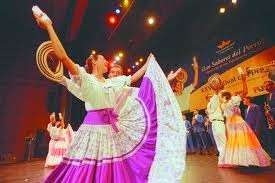NORTHERN REGION
ATLANTIC AND CARIBBEAN
The Cumbia
Derived from the African word "devolves" meaning fun or party. It is a Colombian rhythm par excellence, whose origin seems to date around the eighteenth century. Choreography is defined as a dance of seduction, in which women assume a submissive attitude while the man dances around seducing women .... for it uses a bunch of candles to chase it away so the torch moving in circles their partner.
The Mapalé
Mapalé is the name of a fish and the name of a drum. Dancing itself marked African descent in the Caribbean coast. It is said that this dance was the song and dance of fishermen work was performed, accompanied by drums, and fun in the evening to end your day. Watching her today, it appears that transformed labor activity of erotic ecstasy. The way it is danced today differs from what is narrated by the chroniclers.
The Fandango
The origin dates back to Fandango coexistence (S.-XVIII) of the pre-Columbian, Spanish and African cultures; and it is curious to note that the word "fandango" is not only the result of Andalusia, but African roots ("Fundanga ') and indigenous Nahuatl and Quechua.
In Colombia has a major presence in the Atlantic coast. It is a popular street dance, and refers to the act of dancing at carnivals together with non-traditional wind instruments.
Sauce
Sauce is a genre of Latin American music, which emerged in New York. Latin American immigrants, especially from Cuba and Puerto Rico, 70 mixed traditional Latin rhythms with elements of jazz such as the mambo and the cha-cha-cha. They got back to music with various percussion instruments.
Puya
Street dance known in the departments of Cesar and Magdalena since 1885 as a regional expression of party atmosphere, moving at moderate rhythmic hips. You dance with loose couples. The attitude of both women and men is vivacity.





No hay comentarios.:
Publicar un comentario